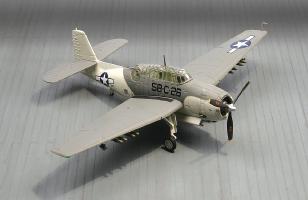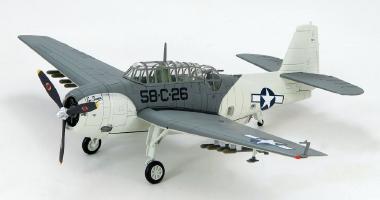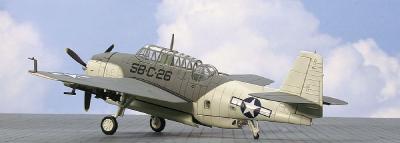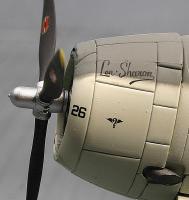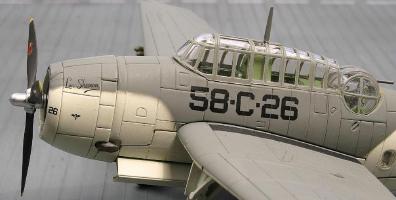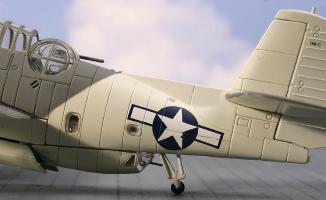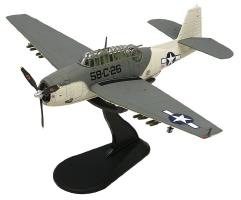Hobby Master Archive
Air Power Propellers 1/72
TBF/TBM
Grumman TBF-1C 58-C-26, VC-58 USS Block Island, January 11, 1944, USN first rocket attack on a U-boat
Hobby Master 1/72 Air Power Series HA1209 Grumman Avenger TBF-1C 58-C-26, VC-58, USS Block Island, January 11, 1944 first USN rocket attack on a U-boat
THESE ARE PRE-PRODUCTION PICTURES NOT THE FINAL PRODUCT
Superb detailing in 1/72 scale. Pre-painted with pad applied markings. Fully assembled. Weapons are not permanently attached. Bomb bay can be displayed open or closed. Display stand included. Option to display model with wheels up or down. Minimum use of plastic. Very collectable.
By 1939 the Douglas Devastator needed to be replaced. The USN tendered for a torpedo bomber with greater range, could carry a larger payload than the Devastator’s, was faster and more durable. Grumman was awarded the contract to deliver their TBF. During the same time as the grand roll out of the new aircraft word came that there had been a disaster. The date was December 7, 1941 Japan had just attacked Pearl Harbor. This would be the start of what would turn out to be one of the best WWII aircraft ever produced. It was because of Japanese attack at Pearl Harbor that the aircraft received its appropriate name, Avenger.
The convoys in the Atlantic Ocean were crucial for the supplying England and Allied troops with everything from food to fighters. If the ships didn’t get through it would mean WWII would continue for much longer and cost unimaginable numbers of lives. A team system was developed to handle the situation. It was comprised of Destroyers protecting Escort Aircraft Carriers (CVEs) that were the base for TBF and F4Fs. Using their ability for long endurance and a large payload of multiple 250-pound, 325-pound, or (most often) 500-pound depth bombs and rockets the Avengers would search for surfaced U-boats and then dive on them releasing their torpedoes. Sometimes due to flak fire from the subs the TBF would stand off out of range of the guns while an F4F Wildcat would be called in. With its large machine guns and speed the F4F would put an end to the flak fire giving the TBF time to move in and drop the torpedo. Some figures say over 35 U-boats were sunk by US air groups using this method. This doesn’t take into account the subs that were sunk by British Avengers that operated from land bases. The crew of Lt. (jg) Leonard McFord spotted one such sub and is credited with the first use of rockets by a US aircraft to attack a submarine. One other notable incident was the sinking of the Japanese submarine I-52 in 1943. It was in the Atlantic and carrying a stockpile of items that were needed by Germany who in turn were going to supply Japan with much needed items. The sub was spotted and attacked by 2 Avengers from USS Bogue that sent the I-52 to the bottom.
There was a total 9,839 Avengers produced in all variants with 2,293 TBFs being built by Grumman. The other 7,546 were TBMs built by Eastern Aircraft, a subsidiary of General Motors.
TBF-1C Specifications Dimensions Length: 40’ 11.5" Height: 16’ 9" Wing Span: 54’ 2"
Weight Max Weight: 17,364 lbs Empty Weight: 10,500 lbs Engine & Power 1 X Wright R-2600-8 radial engine Power: 1700 HP at sea level Performance Stall Speed: 77 mph IAS Max Speed: 249 mph Ceiling: 21,400 ft Rate of climb: 1,400 fpm at sea level Range: 1,100 miles Armament 2 X .50 cal machine guns in turret 2 X .50 cal machine guns in wing 1 X .30 gun in tail Various bombs or torpedo.
PHOTOS ARE COURTESY OF (HISTORIC SALES - HISTORIC AVIATION) THE NORTH AMERICAN DISTRIBUTOR FOR HOBBY MASTER
| Added to archive | 2016-08-01 |
| Last modified | 2016-08-01 |
| Leaflet | 2008-05-01 May 2008 |
